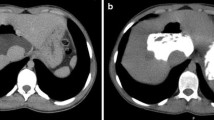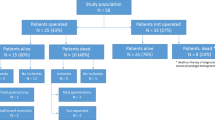Abstract
Purpose
This study was done to assess the prevalence and clinical impact of non-hepatodiaphragmatic interpositions in a sample of adult patients undergoing computed tomography (CT) for a variety of medical reasons.
Materials and methods
From November 2008 to April 2009, two observers jointly examined the cases of intestinal interposition in 4,338 adults undergoing CT investigations. This study sought to identify not only hepatodiaphragmatic intestinal interpositions, defined as Chilaiditi, but also other forms of intestinal interposition, which we termed non-Chilaiditi. The latter were divided into five different classes on the basis of their anatomical relationships: splenorenal, retrogastric, hepatocaval, retrosplenic, and retrorenal. Moreover, a questionnaire investigating the clinical symptoms reported to be associated with Chilaiditi syndrome was given to patients exhibiting any form of intestinal interposition and to a control sample. Finally, clinical data related to the three groups were compared.
Results
Of the 4,338 patients examined, 130 (3%) were found to have intestinal interposition, for a total of 143 forms: 90 Chilaiditi and 53 non-Chilaiditi. Of the latter, 30 were splenorenal, 12 retrogastric, five hepatocaval, four retrosplenic and two retrorenal. Statistical analysis showed that the Chilaiditi group suffered most symptoms (24.4%), followed by the non-Chilaiditi group (18.9%) and control cases (10.8%). Our results were validated using the χ2 test of significance.
Conclusions
The number of non-Chilaiditi cases amounted to just over half the number of Chilaiditi cases, with the splenorenal form being by far the most frequent. Statistical analysis showed that patients with non-Chilaiditi forms of intestinal interposition had more symptoms than did controls.
Riassunto
Obiettivo
Scopo del nostro lavoro è stato valutare la prevalenza e l’impatto clinico delle forme di interposizione intestinale non epatodiaframmatiche in una popolazione adulta studiata con tomografia computerizzata (TC) per differenti indicazioni medico-chirurgiche.
Materiali e metodi
Da novembre 2008 ad aprile 2009, due autori hanno valutato insieme i casi di interposizione intestinale su 4338 pazienti adulti sottoposti a indagini TC. In tale studio, sono state evidenziate sia interposizioni di tipo epatodiaframmatico, che sono state definite Chilaiditi come da letteratura, sia altri tipi di interposizione definite secondo i diversi rapporti anatomici: splenorenale, retrogastrica, epatocavale, retrosplenica e retrorenale, che sono state raggruppate sotto il termine non-Chilaiditi. È stato successivamente sottoposto ai pazienti dei due gruppi e ad un gruppo controllo un questionario relativo ai disturbi clinici associati più frequentemente alla sindrome di Chilaiditi. Sono stati quindi comparati i dati clinici relativi ai tre gruppi.
Risultati
Su 4338 pazienti sono stati osservati 130 (3%) pazienti con interposizione colica per un totale di 143 manifestazioni, 90 Chilaiditi e 53 non-Chilaiditi: 30 interposizioni di tipo splenorenale, 12 di tipo retrogastrico, 5 epatocavale, 4 retrosplenico e 2 retrorenale. L’analisi statistica ha evidenziato che le forme di Chilaiditi producono una maggiore sintomatologia (24,4%), seguite dalle forme non-Chilaiditi (18,9%) e infine dai casi controllo (10,8%). Tale analisi è stata validata dal test di significatività χ2.
Conclusioni
Le forme non-Chilaiditi hanno rappresentato più della metà delle forme Chilaiditi, con la manifestazione splenorenale di gran lunga la più frequente. Abbiamo inoltre evidenziato che anche le forme non-Chilaiditi sono statisticamente più sintomatiche dei casi controllo.
Similar content being viewed by others
References/Bibliografia
Vessal K, Borhanmanesh F (1976) Hepatodiaphragmatic interposition of the intestine (Chilaiditi’s syndrome). Clin Radiol 27:113–116
Chilaiditi D (1910) Zur Frage der hepatoptose und Ptose im allgemeinen im Anschluss an drei Falle von temporaere, partellier Leberverlagererung. Fortschr Geb Rontgenstr Nuklearmed Erganzungsband 16:173–208
Brian T (1992) The colon. In: Sutton D (ed) A text book of radiology and imaging, 5th edn. Churchilll Livingstone, London, pp 857–880
Oldfield AL, Wilbur AC (1993) Retrogastric colon: CT demonstration of anatomic variations. Radiology 186:557–561
Kolju KJ (1938) Roentgen diagnosis of hepatodiaphragmatic interposition of the large intestine. ARJ Am J Roentgenol 39:928–936
Nakagawa H Toda N (2006) Prevalence and sonographic detection of Chilaiditi’s sign in cirrhotic patients without ascites. AJR Am J Roentgenol 187:589–593
Poppel MH, Herstone ST (1942) Anomalies of position of the transverse colon. Am J Surg 57:38–42
Poppel MH (1960) Duodenocolic apposition AJR Am J Roentgenol 83:851–856
Whalen JP, Bader CM, Wolfram R (1974) Evaluation of the retrogastric space: normal appearance and variation. AJR Am J Roentgenol 121:348–356
Balthazar EJ (1977) Congenital positional anomalies of the colon: radiographic diagnosis and clinical complications. I. Abnormalities of rotation. Gastrointest Radiol 2:41–47
Balthazar EJ (1977) Congenital positional anomalies of the colon: radiographic diagnosis and clinical complications. II. Abnormalities of fixation. Gastrointest Radiol 2:49–56
Dodds WJ, Foley WD, Lawson TL et al (1985) Anatomy and imaging of the lesser peritoneal sac. AJR Am J Roentgenol 144:567–575
Birsen U, Simay K, Aykut A, Yasemin B (2004) Kolonun Bt’ de saptanan anatomik varyasyonlari. Tanısal ve Giriflimsel Radyoloji 10:304–308
Choussat H, Choussat-Clausse J (1937) Deux cas d’interposition hepatodiaphragmatic du colon avec autopsies. Bulletin et Memoires de la Société de Radiologie Medicale de France 25:147–154
Murphy JM (2000) Chilaiditi’s Syndrome and Obesity. Clinical Anatomy 13:181–184
Orangio GR, Fazio VW, Winkelman E (1986) The Chilaiditi syndrome and associated volvulus of the transverse colon: an indication for surgical therapy. Dis Colon Rectum 29:653–656
Lekkas Cn, Lentino W (1978) Symptom-producing interposition of the colon: clinical syndrome in mentally deficient adult. JAMA 240:747–750
Jackson AD, Hodson CJ (1957) Interposition of colon between liver and diaphragm (Chilaiditi’s syndrome) in children. Arch Dis Childhood 32:151–158
Author information
Authors and Affiliations
Corresponding author
Rights and permissions
About this article
Cite this article
Bredolo, F., Esposito, A., Casiraghi, E. et al. Intestinal interposition: the prevalence and clinical relevance of non-hepatodiaphragmatic conditions (non-Chilaiditi forms) documented by CT and review of the literature. Radiol med 116, 607–619 (2011). https://doi.org/10.1007/s11547-011-0665-x
Received:
Accepted:
Published:
Issue Date:
DOI: https://doi.org/10.1007/s11547-011-0665-x




